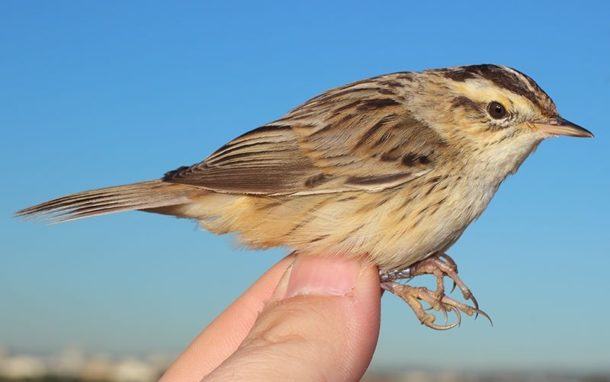
CITRIC FESTIVAL, urban art promoted by Infertosa
30 de August de 2023
HIDROSEEDING WITH INFERTOSA
30 de August de 2023A scientific ringing campaign confirms the passage of the Aquatic Warbler in Valencia during its spring migration: 24 specimens were found this year compared to 7 last year. The action, which has been carried out simultaneously in four wetlands, is part of the European project LIFE Paludicola whose aim is to halt the decline of the Aquatic Warbler population.
LIFE-Paludicola
The LIFE project, developed by the Fundación Global Nature, the main objective is to stop the decline of Aquatic Warbler populations through actions to restore pre- and post-nuptial migratory habitat. These actions will be carried out during the period 2017-20 in 12 municipalities of three Spanish regions (Castilla-La Mancha, Castilla y León and Comunidad Valenciana), all of them included in Natura 2000 Network sites. The initiative is co-financed by the European Union’s LIFE programme and the partners are the Global Nature Foundation and the Regional Government of Castilla y León. The project is supported by the Ministry of Agriculture, Environment, Climate Change and Rural Development of the Generalitat Valenciana, the Ministry for Ecological Transition through the Fundación Biodiversidad, the Torreblanca City Council and the company INFERTOSA.
The Aquatic Warbler
 The Aquatic Warbler is a small bird, 13 cm long and 10 grams in weight, which is capable of travelling 6,000 kilometres every migratory journey between its breeding quarters and its wintering quarters. The Aquatic Warbler (Acrocephalus paludicola) is listed as globally Vulnerable, classified as Endangered at European level, and is included in Annex I of the Birds Directive, Annex II of the Bern Convention and Annex II of the Bonn Convention. In addition, it is listed as of Special Interest in the National Catalogue of Threatened Species and as Vulnerable in the latest Red Book of the Birds of Spain. It is a priority species for conservation at a global level because it is globally threatened with an estimated world population of less than 30,000 breeding individuals. This very low population compared to other more common small bird populations, together with the fragmentation of their breeding areas and their population decline, highlights their high risk of extinction.
The Aquatic Warbler is a small bird, 13 cm long and 10 grams in weight, which is capable of travelling 6,000 kilometres every migratory journey between its breeding quarters and its wintering quarters. The Aquatic Warbler (Acrocephalus paludicola) is listed as globally Vulnerable, classified as Endangered at European level, and is included in Annex I of the Birds Directive, Annex II of the Bern Convention and Annex II of the Bonn Convention. In addition, it is listed as of Special Interest in the National Catalogue of Threatened Species and as Vulnerable in the latest Red Book of the Birds of Spain. It is a priority species for conservation at a global level because it is globally threatened with an estimated world population of less than 30,000 breeding individuals. This very low population compared to other more common small bird populations, together with the fragmentation of their breeding areas and their population decline, highlights their high risk of extinction.
The Valencian marshlands are resting places for Europe’s most endangered passerine.

The resting places on any journey are essential to its successful completion. If the trip is about 6,000 kilometers long, these resting places are essential. Now it is confirmed that the Valencian wetlands are those reference sites for the most threatened passerine species in Europe: the Aquatic Warbler. Thanks to the second scientific bird ringing campaign, which has allowed us to deepen our knowledge of this globally threatened bird and help in its conservation at a global level, the importance of these protected natural areas has been confirmed. The Aquatic Warbler is also a species that is particularly vulnerable to the destruction of its habitat. A total of 24 Aquatic Warblers have been ringed in the spring campaign 2019 compared to 7 last year 2018. The improved water conditions of the wetlands this season, the recovery of the vegetation after the fires of winter 2017-18, together with the improvement actions initiated with the Paludicola LIFE may be the cause of this increase.
This action has chosen the Valencian marshlands to carry out this campaign. Specifically, in the Prat de Cabanes-Torreblanca, 7 birds were captured; in the Tancat de la Ratlla (La Albufera), 6 birds; in the Marjal dels Moros, 10 birds and in the Pego-Oliva marsh, 1 bird. All this, in spite of the presence of a strong squall for several days that interrupted the ringing work.
More than a thousand catches
Thanks to these campaigns, other species of birds are also captured, some of which are resident throughout the year in Valencia, but also other migratory species. Thus, 1,126 captures of 53 species were made. Among them, the most abundant were the Musical Warbler, the Common Warbler and the Blackcap, all of them with more than 100 captures of each species. In addition, specimens of rare species in the Iberian geographical area stand out, such as the Little Crake and the Whistling Warbler, or very threatened swamp species such as the Royal Warbler. Even the absence of the Moustache, in regression throughout Spain, is striking. Birds from other Spanish and foreign ringing stations have also been captured, which will contribute to a better understanding of their migratory strategies.

Colirrojo real (A. Miguel Piera)

Mosquitero musical ( (A. Miguel Piera)


